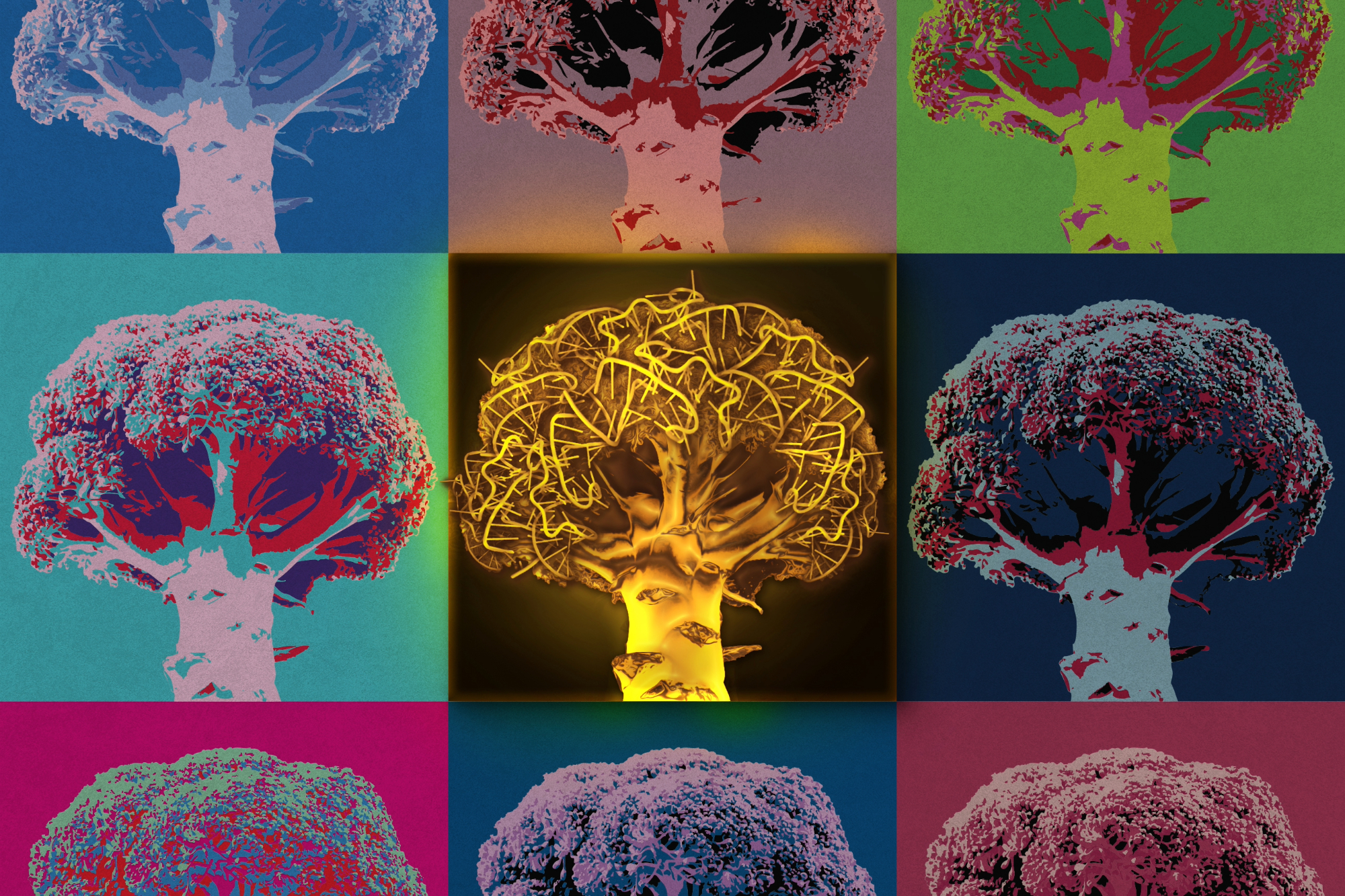Breakthrough Biosensor Tracks Glycine in Living Cells
September 22, 2025
Above: The pop art-inspired illustration highlights a new light-up RNA aptamer called Golden Broccoli that was developed through structure-based design.
Golden Broccoli: U biochemists create the world’s first single-dyed ratiometric biosensor for glycine imaging.

Madeline Bodin
“Glycine has many important roles. It’s an important neurotransmitter that regulates things like memory reflex and brain development, and it also may be a biomarker for bacterial virulence,” notes Madeline Bodin, a University of Utah doctoral candidate in the Hammond lab. She is the lead author of a new paper titled “Visualizing intracellular glycine with two-dye and single-dye ratiometric RNA-based sensors.”
Of all the amino acids, the building blocks of proteins, glycine is the simplest. Out of the 20 standard amino acids, it is the only one lacking a side chain extending from its backbone. “But, despite all of these important roles of glycine, there haven’t been any tools that can image glycine both inside and outside of living cells,” adds faculty member and corresponding author of the paper Ming Hammond.
Golden Broccoli
And so, Bodin and Hammond went out and created one using engineered strands of RNA called aptamers. This wasn’t easy. Through persistent work, they created a new aptamer called “Golden Broccoli” that is used alongside the previously existing “Red Broccoli” aptamer to bind with a single dye and emit yellow and red light, respectively.
“The yellow signal indicates how much of the RNA sensor is in the cell,” explains Bodin. “The red signal indicates how much glycine is present. You can use the ratio between these signals for absolute quantitation.”
This is where the term ratiometric comes in. When the aptamers lights up, yellow and red lights are emitted mixed together. It’s more of a mix between the two. “The two signals have some overlap. Luckily, it turns out you can unmix these signals using mathematical formulas,” says Hammond. The best part now is that glycine levels can be read very accurately in real time with living cells, without breaking open the cells and killing them in the process.
“Any questions we have about how the amount of glycine in the cell changes during different cellular processes or where glycine is located in the cell at different times now can be answered,” explains Bodin.
This new tool can help us make measurements to test and improve fundamental models of cell signaling and behavior.
A glial cell called an astrocyte

Ming Hammond
In the future, at least one application of a more accurate reading of glycine levels is in the human brain, specifically with a glial cell called an astrocyte. Astrocytes are abundant within the central nervous system. They regulate neuronal activity and have a sheath-like role in protecting the brain from injury. Recent studies have hypothesized that astrocytes might provide neurotransmitters to the neurons themselves.
“We want to use the biosensor to determine if astrocytes release glycine in a way that could potentially affect neuronal signaling,” adds Bodin.
Right now, imaging of glycine in the brain is not possible, requiring additional technological advancements. But Bodin and Hammond are optimistic that there will be improvements down the road.
“I'm always thinking of how there's more to be done,” continues Bondin. “Although this was a breakthrough, I hope that in the future other people can develop even brighter single-dye ratiometric aptamers. And in that sense, there's still more work to be done.”
Future imaging tools will be more advanced but the important part about this study is that it is a first. When Bodin and Hammond submitted this paper to the journal Nucleic Acids Research (NAR), all three reviewers nominated it as a Breakthrough Article. NAR publishes thousands of papers per year with only 20 to 35 being selected formally as breakthroughs.
A long time coming
For Bodin, this paper has been a long time coming. For her undergraduate work, she attended Ohio Wesleyan University where she double majored in chemistry and neuroscience. Her first experience at the U was as a participant in the Research Experiences for Undergraduates (REU) in Chemistry program, currently co-led by Hammond. As a Ph.D. candidate, Bodin took part in the PITCH program which provides interdisciplinary training for chemical biology. While REU helped Bodin find the U, PITCH provided integral training. The combination of the two led to an impressive breakthrough.
Golden Broccoli will inevitably lead to future advancements. It can tell us the big things that the simple little glycine molecule is up to.
The paper was published September 11, 2025 in the journal NAR.
By Nathan Murthy
About the Hammond Lab: The Hammond Laboratory at the University of Utah has a dual focus on engineering nucleic acids as programmable tools for molecular imaging and gene control, and on understanding the chemistry and biology of cyclic dinucleotides as signaling molecules in bacteria and mammalian cells. The investigators and work in this study were supported by the National Science Foundation, the National Institutes of Health, and the National Cancer Institute
